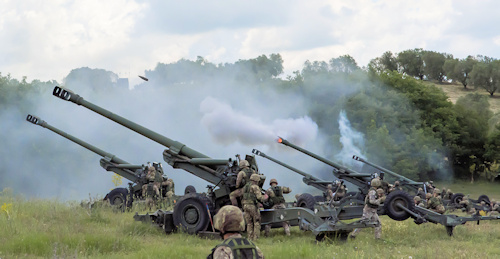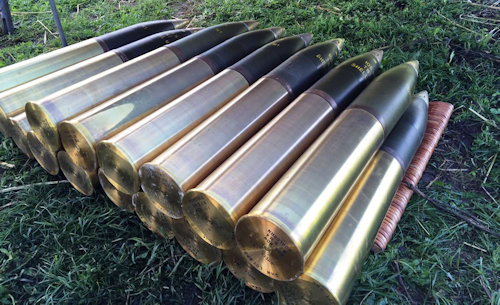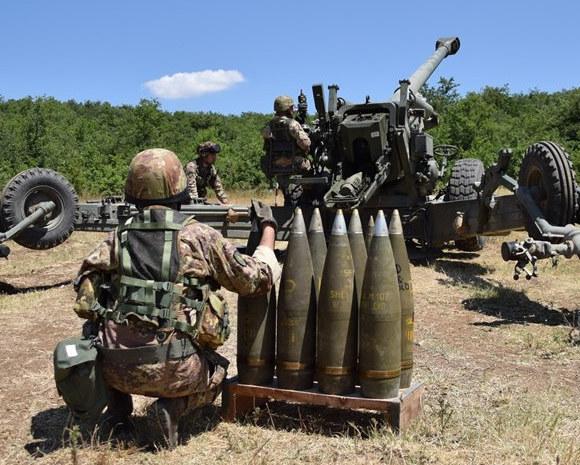Currently deployed by the three regiments of terrestrial artillery (the 185 ° rgt art. Paratroopers of the brigade thunderbolt employs the MO-120 RT striped mortars from the Army 120 mm), the FH-70 campaign howitzer from 155 / 39 mm is the product of an international collaboration.
In the 1968 a memorandum of understanding is signed by the United Kingdom and the Federal Republic of Germany for the joint development of an 155 mm howitzer intended to replace the British 140 mm cannon and the M-114 howitzer from 155 mm supplied to the army West German.
The main specifications for the piece were: high speed of shooting with fast shooting ability; range and lethal effects increased by the use of a new series of ammunition; high mobility and easy battery charging.
19 prototypes are built (in the meantime, the project is called FH-70) and, in 1970, Italy is fully associated with the project.
The new howitzer is built in three production lines: one in the United Kingdom (Vickers Shipbuilding an Engineering Ltd), one in the Federal Germany (Rheinmetall), one in Italy (OtoMelara).
 The United Kingdom ordered 71 pieces, Germany 216 and Italy 164.
The United Kingdom ordered 71 pieces, Germany 216 and Italy 164.
The carriage has retractable tails and an auxiliary motor (APU) is installed in its front part. This allows the howitzer to move independently on the road and in varied terrain at the maximum speed of 16 km / h. The weight in running gear and combat is equal to 9.300 kg.
To satisfy the need for rapid shooting, a semi-automatic loading system is installed that works at any angle of elevation. A maximum shooting speed of three shots can be achieved in 13 seconds, while the normal speed is six strokes per minute.
The FH-70 howitzer uses four main types of projectiles: HE weighing 43,5 kg; the foggy (ejection from the bottom); the illuminant (delivers one million candles for one minute); the American semi-automatic projected M-549A1, which has a range of 30.000 meters.
 Recently the 3 ° Mountain Artillery Regiment of the Brigade Julia is experiencing the return to service of howitzers from Oto 56 from 105 / 14 mm, withdrawn from service for several years.
Recently the 3 ° Mountain Artillery Regiment of the Brigade Julia is experiencing the return to service of howitzers from Oto 56 from 105 / 14 mm, withdrawn from service for several years.
Designed for the operational needs of the Alpine brigades (ease of transport on mountainous terrain) and the paratroopers brigade (possibility of aviolancio), the hinging howitzer Oto Melara 56 from 105 mm entered production in the 1957 and was adopted by many other countries. In the 1984, 2.400 had been produced exemplary, used in military operations in many theaters.
The British used it in southern Yemen and during the conflict in Borneo; the Argentines in the Falkland countryside.
The howitzer has a very short flame inlet with multi-deflector brake, hydropneumatic brake and helical recovery spring, vertical sliding wedge shutter. The carriage is of the type with retractable tails and the wheels are equipped with tires for high-speed towing.
 The 56 model can be broken down into 11 loads for transportation by somewhere in varied terrain, and in the exercises the shield is removed to reduce weight. The howitzer can be pulled by a Lynx or it can be carried suspended by an AB-205 helicopter.
The 56 model can be broken down into 11 loads for transportation by somewhere in varied terrain, and in the exercises the shield is removed to reduce weight. The howitzer can be pulled by a Lynx or it can be carried suspended by an AB-205 helicopter.
The ammunition includes a HE project with the weight of 21 Kg that the maximum initial speed of 472 m / sec., But can also use HEAT projectiles that weigh 16,7 Kg and can drill 102 mm of steel.
In the Italian Army it had been replaced by French heavy mortars by 120 mm, however years of missions abroad have shown the usefulness of being able to have a piece of artillery with different ballistic and transport characteristics, such as those owned by the Oto 56 from 105 / 14 mm.
Photo: Italian Army












